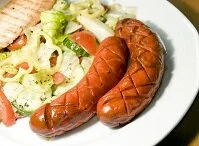As you eat in Hungary, keep your knife in your right hand, fork in the left, and try everything; turning down food is like rejecting your host's hospitality. You should also keep your hands in sight throughout the meal. As your meal comes to a conclusion, leave a little food on your plate. Also, throughout the meal your wine glass will be refilled as soon as it is half empty, so if you're finished drinking, leave at least half your glass full so it's not refilled.

Sausages
If eating in a restaurant, particularly with business associates, the event is more formal. In these situations the inviter is expected to pay for everyone in a discreet manner, by excusing him or herself and paying the server directly. However if only going to dinner with friends, the bill is typically divided evenly.
Tipping is more common in Hungary than in most of Europe. When eating at a sit down restaurant, you should tip about 10% of the bill, although sometimes a service charge is already added to a bill and tipping on top of this is unnecessary. When you pay your waiter or waitress at a restaurant, tell him or her how much change you want back so your payment includes both the bill and tip; leaving money on the table seems odd to Hungarians.
Drinks
Many Hungarians start their day with a cup of coffee, however the coffee house scene is still developing in the country outside the capital. In addition to this favorite, all popular international drinks are available, including soft drinks, tea, juices, and milk.
For alcohol, the Hungarians love their wine, beer, and palinkahe, a local alcohol distilled from fruits. The beer options are numerous including local beers as well as imports from nearby neighbors like Austria, Germany, and the Czech Republic. Many wines sold in Hungary are locally grown and produced; many of these tend to fall on the sweeter side of the spectrum, particularly their white wines. All popular beers, wines, and hard liquors are also commonly available.
Generally speaking, the tap water is safe to drink in Hungary, but check with locals for any particular regional differences. Also, many people may have troubles adjusting to the local tap water, as it will most certainly be different from what your system is used to.